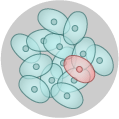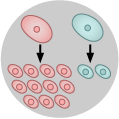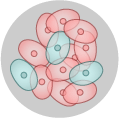 This month, pink products — from sneakers to vacuum cleaners — will pop up on store shelves. Even Campbell’s Soup will shed its tomato red label in favor of pearly pink. Whatever your opinion on the pink campaign to raise awareness of and research dollars for breast cancer, the cause is unlikely to escape your notice during October, National Breast Cancer Awareness Month. Since nearly 200,000 women in the United States will be diagnosed with breast cancer this year alone, funding for research has the potential to improve the quality of life and survival odds for many millions of people. But despite increased attention and funding, the cure for this and other cancers has remained notoriously elusive. Viewing cancer through the lens of evolution helps explain why a cure seems to remain just out of reach and points the way toward new treatments.
This month, pink products — from sneakers to vacuum cleaners — will pop up on store shelves. Even Campbell’s Soup will shed its tomato red label in favor of pearly pink. Whatever your opinion on the pink campaign to raise awareness of and research dollars for breast cancer, the cause is unlikely to escape your notice during October, National Breast Cancer Awareness Month. Since nearly 200,000 women in the United States will be diagnosed with breast cancer this year alone, funding for research has the potential to improve the quality of life and survival odds for many millions of people. But despite increased attention and funding, the cure for this and other cancers has remained notoriously elusive. Viewing cancer through the lens of evolution helps explain why a cure seems to remain just out of reach and points the way toward new treatments.
Where's the evolution?
Iconic examples of evolution (birds evolving from dinosaurs, hominids evolving an upright posture, or a lineage of lobe-finned fish evolving four legs and moving onto land) might seem unrelated to the growth of a cancerous tumor, but the process underlying them both — natural selection — is identical. We typically think of natural selection acting among individuals, favoring those carrying advantageous traits and making those traits more common in the next generation. However, the key elements of this process — variation, inheritance, and selective advantage — characterize not just populations of organisms in a particular environment, but also populations of cells within our own bodies. The cells lining your intestines, for example, are not genetically uniform; there is variation among them. Some of those cells have incurred chance mutations as they have divided. If one of those mutations (or a series of mutations) allows its bearer to evade cell death and reproduce more prolifically than others, it will pass that mutation on to its daughter cells, and cells bearing that mutation will increase in frequency over time. Like organisms in an ecosystem, cell lineages within one’s own body compete for resources. A cell lineage that gains an advantage in that competition, accumulating mutations that allow it to grab extra resources and escape the body’s control mechanisms, will proliferate and may evolve into a cancerous tumor.
Natural selection within a cell lineage
 1. Variation in traits.
1. Variation in traits.
Most of the cells are basically the same, but one has experienced a chance mutation, inactivating a gene that controls the cell’s growth.
 2. Differential birth and death.
2. Differential birth and death.
Because it has lost the ability to regulate growth, the cell with the chance mutation divides more rapidly than the others.
 3. Heredity.
3. Heredity.
The normal cells pass on normal DNA when they divide, and the mutant cells pass on mutant DNA when they divide.
Though the evolution of a population in an ecosystem and cell lineages in a body rely on the same basic process, there are a few key differences between selection at these different levels. First, whole organisms reproduce much more slowly than individual cells do. This means that while the evolution of a new species or a major transition (such as the evolution of birds from dinosaurs) may take millions of years, the evolution of a cell lineage into a cancerous form can take place on the scale of months or years. Second, natural selection generally increases the evolutionary fitness of individuals, favoring those whose traits allow them to survive and produce more healthy offspring; however, selection at lower levels may increase the fitness of cellular lineages at the cost of the individual. In the case of cancer, this is especially obvious: cancerous cells have an advantage in comparison to other cells in the body, but are disadvantageous to the organism. Selection at the cellular level may wind up hampering the organism’s survival and reproduction, acting in exact opposition to selection at the individual level.
Why has counteracting these negative effects at the level of the individual (i.e., finding a cure) been so difficult? An evolutionary perspective reveals the answer: cancer — even within one person — isn’t a single entity. It’s a diverse and evolving population of cell lineages. A single tumor, for example, is made up of a variety of cell types, produced as the cells proliferated and incurred different mutations. All of this diversity means that the population of cells could easily include a mutant variety that happens to be resistant to any individual chemotherapy drug we might administer. To make matters even more difficult, treating the patient with that drug creates an environment in which the few resistant cancer cells have a strong selective advantage in comparison to other cells. Over time, those resistant cells will increase in frequency and continue to evolve. It’s not surprising then that a simple cure for cancer has yet to be developed: treating even a single type of cancer is a bit like trying to take aim at a whole set of moving targets all at once.
While an evolutionary perspective emphasizes the slim prospects for a discovering a magic-bullet cure for cancer, it also highlights the potential effectiveness of several treatment strategies, some currently in use and some still in development:
- Emphasize early detection. The less time that a cancerous cell lineage has to evolve, the less diverse that population of cells will become and, consequently, the easier it will be to target the rogue cells as a group.
- Attack early cancer aggressively. Cancer’s ability to evolve and evade our assaults resides in its diversity, which increases over time. Some oncologists argue that our best chance at eradicating the cancer cells entirely may be before they’ve had time to evolve into a diverse population.
- Use a combination of drugs. Within a large population of cancer cells, the odds are relatively high that at least one cell carries a mutation conferring resistance to a particular drug. However, the odds of a single cell being resistant to several different drugs are much lower. Similar approaches have been successful with other practical evolutionary challenges, such as controlling evolving populations of crop pests and treating diverse and evolving HIV infections.
- Bypass cancer’s diversity. Cancer cells are diverse, but their growth seems to rely on a stable set of biological processes within the body. For example, cancerous tumors get the extra nutrients and oxygen they need by inducing the formation of new blood vessels, and there is little diversity in how these blood vessels form. If we could inhibit the development of these vessels, we might be able to control the reproduction and spread of cancerous cells. Such treatments would bypass the genetic diversity of cancer cells by targeting processes outside the cells themselves.
- Manipulate the cellular competition. As cancerous cells reproduce and evolve, these different cell lineages compete with one another — and, unfortunately for the patient, natural selection tends to favor the lineages that reproduce and spread most quickly and that are least susceptible to our treatments. However, researchers are looking for ways to manipulate that competition to help benign or non-drug-resistant cell lineages outcompete their more aggressive counterparts, skewing the evolutionary competition to benefit the patient.
Treating cancer means controlling a diverse population of rapidly evolving cell lineages. This challenge helps explain why research has not yet provided us with a cure, but also points the way toward new solutions that take that evolution into account. Research into developing and optimizing these treatments continues, aided by funds generated through events such as National Breast Cancer Awareness Month. Pink sneaker sales and fundraising walks may seem unrelated to evolution, but the cause that they represent is an inherently evolutionary problem.
Primary literature:
- Merlo, L. M. F., Pepper, J. W., Reid, B. J., and Maley, C. C. (2006). Cancer as an evolutionary and ecological process. Nature Reviews Cancer 6:924-935. Read it »
News articles:
- A summary of the links between evolution and cancer from Howard Hughes Medical Institute
- A review of recent research on the evolutionary underpinnings of cancer from Science Daily
Understanding Evolution resources:
- Describe the basic characteristics necessary for evolution via natural selection to occur.
- Read this review of natural selection acting at different levels of the biological hierarchy. The article above describes how natural selection acts on two levels of this hierarchy: populations of organisms and cell lineages. Describe a third level of the hierarchy at which natural selection can act. Explain how that situation meets the criteria necessary for natural selection to occur.
- What does evolutionary fitness mean for a cell lineage? Describe how this differs from the concept of fitness at the level of the whole organism.
- The article above describes how selection at the level of the cell lineage can decrease the fitness of individuals. Can selection at the level of the individual decrease the fitness of cell lineages? If yes, give an example. If no, describe why not.
- Explain why its genetic variation makes cancer difficult to treat.
- Teach about natural selection: In this classroom activity for grades 9-12, students learn why evolution is at the heart of a world health threat by investigating the increasing problem of antibiotic resistance in such menacing diseases as tuberculosis.
- Teach about selection and medical applications: This article for grades 9-12 examines how scientist Andy Ellington has co-opted the power of artificial selection to construct new, useful molecules in his lab. The results of his work could help protect us from terrorist attacks and fight HIV and cancer.
- Teach about applications of evolutionary biology in medicine: This tutorial for grades 9-12 explores just a few of the many cases in which evolutionary theory helps us understand and treat disease. Bacterial infections, HIV, and Huntington's disease are highlighted.
- Greaves, M. (2000). Cancer: The evolutionary legacy. Oxford: Oxford University Press.
- Merlo, L. M. F., Pepper, J. W., Reid, B. J., and Maley, C. C. (2006). Cancer as an evolutionary and ecological process. Nature Reviews Cancer 6:924-935.
- Susan G. Komen for the Cure. Breast cancer statistics. Retrieved January 14, 2010, from Susan G. Komen for the Cure
